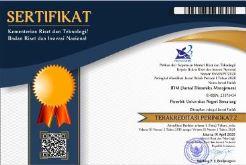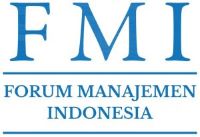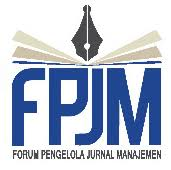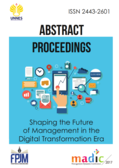The Effects of Store Environment and Merchandise to Customer Responses: an Empirical Study
Abstract
Keywords
Full Text:
PDFReferences
Badan Pusat Statistik. 2015. Statistik Jumlah Toko di Indonesia. Available at: https://www.bps.go.id/publikasi.html. February 9, 2016.
Baker, J., Grewal, D & Parasuraman, A. 1994. The Influence of Store Environment on Quality Inferences and Store Image. Journal of the Academy of Marketing Science. 22 (4): 328-339.
Chebat, J. C & Michon, R. 2003. Impact of Ambient Odors on Mall Shoppers’ Emotions, Cognition, and Spending: a Test of Competitive Causal Theories. Journal of Business Research. 56 (7): 529- 539.
Chen, H. S & Hsieh, T. 2011. The Effect of Atmosphere on Customer Perceptions and Customer Behavior Responses in Chain Store Supermarkets. African Journal of Business Management. 5(24): 10054-10066.
Donovan, R. J & Rossiter, J. R. 1982. Store Atmosphere: an Environmental Psychology Approach. Journal of Retailing. 58: 34-47.
Darlon, E. B. 2007. Adolescent Behavior Research Advance. New York: Nova Science Publishers, Inc.
Floor, K. 2007. Branding a Store: How to Build Successful Retail Brands in a Changing Marketplace. Philadelphia: BIS Publishers.
Hair, J. F. Jr., Black, W. C., Babin, B. J & Anderson, R. E. 2010. Multivariate Data, 7th edition. New Jersey: Pearson Education, Inc.
Halim, L. H. P & Barata, D. D. 2016. Pengaruh Store Environment terhadap Customer Evaluation Serta Dampaknya pada Customer Response di Toko Ritel. Jurnal Widyakala. 3: 29-43.
Hooley, G. J., Piercy, N. F & Nicoulaud, B. 2012. Marketing Strategy and Competitive Positioning. 5th edition. Harlow: Prentice Hall.
Hussain, R & Ali, M. 2015. Effect of Store Atmosphere on Consumer Purchase Intention. International Journal of Marketing Studies. 7 (2): 34-43.
Kaltcheva,V. D & Weitz, B. A. 2006. When Should a Retailer Create an Exciting Store Environment? Journal of Marketing. 70:107-118.
Kumar, A & Kim, Y. K. 2014. The Store as-a Brand Strategy: the Effect of Store Environment on Customer Responses. Journal of Retailing and Consumer Services. 21(2014): 685-695.
Lam, S. Y. 2001. The Effects of Store Environment on Shopping Behaviors: a Critical Review. Advances in Consumer Research. 28 (1): 190-197.
Levy, M & Weitz, B. A. 2012. Retailing Management. New York: McGraw-Hill Irwin.
Lin, M. Q & Chiang, Y. F. 2010. The Influence of Store Environment on Perceived Experiential Value and Behavior Intention. Asia Pacific Management Review. 15 (2): 281-299.
Lunardo, R & Roux, D. 2015. In-Store Arousal and Consumers’ Inferences of Manipulative Intent in the Store Environment. European Journal of Marketing. 49(5/6): 646-667.
Turner, A. 2015. Generation Z: Technology and Social Interest. Journal of Individual Psychology. 71(2): 103-113.
Namkung, Y & Jang, S. S. 2008. Are Highly Satisï¬ed Restaurant Customers Really Different? a quality perception perspective. International Journal of Contemporer Hospitality Management. 20: 142-155.
Newman, A. J & Darshika, P. 2004. The Marketing Directions of Two Fashion Retailers. European Journal of Marketing. 38(7): 770-789.
Olahut, M. R., El-Murad, J & Plaias, I. 2012. Store Atmosphere: Conceptual Issues and Its Impact on Shopping Behavior. International Conference Marketing-from information to decision. 5(2012): 317-343.
Palacios, L. L., López, R. P & Redondo, Y. P. 2016. Cognitive, Affective and Behavioural Responses in Mall Experience: a Qualitative Approach. International Journal of Retail & Distribution Management. 44 (1): 4-21.
Parsad, C., Prashar, S & Sahay, V. 2017. Impact of Impulsive Personality Traits and Store Environment on Impullse Buying Behavior. 23 (1): 1-24.
Purwa, E. M. R. G & Yasa, N. N. K. 2014. Strategi Store Environment dan Time Pressure pada Pembelian Impulsif melalui Emotional State. Jurnal Dinamika Manajemen. 5(2): 147-160.
Pitchayapa, S & Kim, S. 2016. Influences of Store Atmosphere on Purchase Intention toward a Fast Fashion Brand in Bangkok. Journal Retailling. 3.
Rubin, A & Babbie, E. R. 2012. Essential Research Methods for Social Work, 2nd edition. United States of America: Cengage Learning.
Saad, M & Metawie, M. 2015. Store Environment, Personality Factors and Impulse Buying Behavior in Egypt: The Mediating roles of Shop Enjoyment and Impulse Buying Tendencies. Journal of Business and Management Science. 3(2): 69-77.
Sachdeva, I & Goel, S. 2015. Retail Store Environment and Customer Experience: a Paradigm. Journal of Fashion Marketing and Management: an International Journal. (19)3: 290-298.
Santoso. 2011. Structural Equation Modelling (SEM) Konsep dan Aplikasi dengan AMOS 18. Jakarta: PT. Elex Media Komputindo Kompas Gramedia.
Sarwono, J. 2012. Mengenal PLS-SEM. Yogyakarta: Andi Offset.
Singh, P., Katiyar, N & Verma, G. 2014. Retail Shoppability: The Impact of Store Atmospherics & Store Layout on Consumer Buying Patterns. International Journal of Scientific & Technology Research. 3(8) : 15-23.
Yoo, C., Park, J & MacInnis, D. J. 1998. Effects of Store Characteristics and In-Store Emotional Experienceson Store Attitude. Journal Business Research. 42: 253-263.
Zentes, J. 2016. Strategic Retail Management Text and International Cases. Wiesbaden: Gabler.
View Counter: Abstract - 1927 and PDF - 1179
Refbacks
- There are currently no refbacks.





